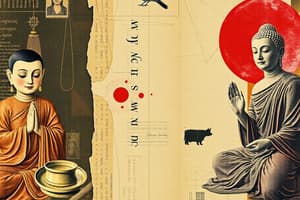Podcast
Questions and Answers
What is the primary aim of Buddhism as described by the Four Noble Truths?
What is the primary aim of Buddhism as described by the Four Noble Truths?
- To understand the immortality of the soul
- To practice asceticism and renounce the material world
- To avoid suffering and attain Nirvana (correct)
- To attain enlightenment through meditation
Which of the following is NOT one of the Four Noble Truths?
Which of the following is NOT one of the Four Noble Truths?
- Desire is the root cause of suffering
- There is a fixed ultimate civilization (correct)
- Life is full of sorrow
- There is a path to the cessation of sorrow
Which path is emphasized in Buddhism as a means to achieve the cessation of sorrow?
Which path is emphasized in Buddhism as a means to achieve the cessation of sorrow?
- Dharma Marga
- Ashtangika Marga (correct)
- Madhya Marga
- Dukha Marga
What is the significance of the concept Triratna in Buddhism?
What is the significance of the concept Triratna in Buddhism?
What is Pratityasamutapada also known as in Buddhist doctrine?
What is Pratityasamutapada also known as in Buddhist doctrine?
Which subsect of Mahayana Buddhism is associated with the founder Nagarjuna?
Which subsect of Mahayana Buddhism is associated with the founder Nagarjuna?
What is the key belief of the followers of Vajrayana Buddhism regarding salvation?
What is the key belief of the followers of Vajrayana Buddhism regarding salvation?
Which Bodhisattva is known as the lord who looks down and is also referred to as Padmapani?
Which Bodhisattva is known as the lord who looks down and is also referred to as Padmapani?
Which of the following is NOT one of the four principal events of Buddha's life represented by sacred shrines?
Which of the following is NOT one of the four principal events of Buddha's life represented by sacred shrines?
Which of the following locations is NOT considered one of the eight holy places (Ashtasthanas) of Buddhism?
Which of the following locations is NOT considered one of the eight holy places (Ashtasthanas) of Buddhism?
Who was the chairman of the 2nd Buddhist Council?
Who was the chairman of the 2nd Buddhist Council?
What significant result came from the 3rd Buddhist Council?
What significant result came from the 3rd Buddhist Council?
During which Buddhist Council was the Vinaya Pitaka compiled?
During which Buddhist Council was the Vinaya Pitaka compiled?
Which patron supported the 4th Buddhist Council?
Which patron supported the 4th Buddhist Council?
Which of the following councils led to a significant schism in Buddhism?
Which of the following councils led to a significant schism in Buddhism?
In which year was the 1st Buddhist Council held?
In which year was the 1st Buddhist Council held?
What main text was compiled during the 4th Buddhist Council?
What main text was compiled during the 4th Buddhist Council?
What was a primary feature of the Hinayana sect in Buddhism?
What was a primary feature of the Hinayana sect in Buddhism?
Flashcards
Four Noble Truths
Four Noble Truths
The core beliefs of Buddhism, explaining the nature of suffering and how to overcome it.
Dukkha (Suffering)
Dukkha (Suffering)
The inherent unsatisfactoriness or pain in life.
Eightfold Path
Eightfold Path
The path to end suffering, including right understanding, thought, speech, action, livelihood, effort, mindfulness, and concentration.
Nirvana
Nirvana
Signup and view all the flashcards
Three Jewels (Triratna)
Three Jewels (Triratna)
Signup and view all the flashcards
Vajrayana Buddhism
Vajrayana Buddhism
Signup and view all the flashcards
Bodhisattva
Bodhisattva
Signup and view all the flashcards
Avalokitesvara/Padmapani
Avalokitesvara/Padmapani
Signup and view all the flashcards
Eight Holy Places (Ashtasthanas)
Eight Holy Places (Ashtasthanas)
Signup and view all the flashcards
Buddhist Architecture
Buddhist Architecture
Signup and view all the flashcards
First Buddhist Council
First Buddhist Council
Signup and view all the flashcards
Second Buddhist Council
Second Buddhist Council
Signup and view all the flashcards
Third Buddhist Council
Third Buddhist Council
Signup and view all the flashcards
Fourth Buddhist Council
Fourth Buddhist Council
Signup and view all the flashcards
Tripitaka
Tripitaka
Signup and view all the flashcards
Pali Texts
Pali Texts
Signup and view all the flashcards
Hinayana
Hinayana
Signup and view all the flashcards
Mahayana
Mahayana
Signup and view all the flashcards
Study Notes
Religious Movements (1000 BCE - 400 BCE)
- Various religious movements like Buddhism and Jainism emerged during the Post-Vedic Period, also known as the Second Urbanisation period (6th century BCE to 4th century BCE).
Causes of Religious Movements
- Vedic philosophy lost its purity.
- Vedic religion became complex, riddled with superstitions, dogmas, and rituals.
- Brahminical supremacy caused unrest; Kshatriyas challenged Brahmanical dominance.
- Introduction of new agricultural economies in Eastern India.
- Vaishyas' desire for improved social standing due to increased trade.
Jainism
- Jain tradition recognized 24 Tirthankaras (ford makers across the stream of existence).
- First Tirthankara was Rishabhadeva/Adinatha; last was Mahavira.
Studying That Suits You
Use AI to generate personalized quizzes and flashcards to suit your learning preferences.




